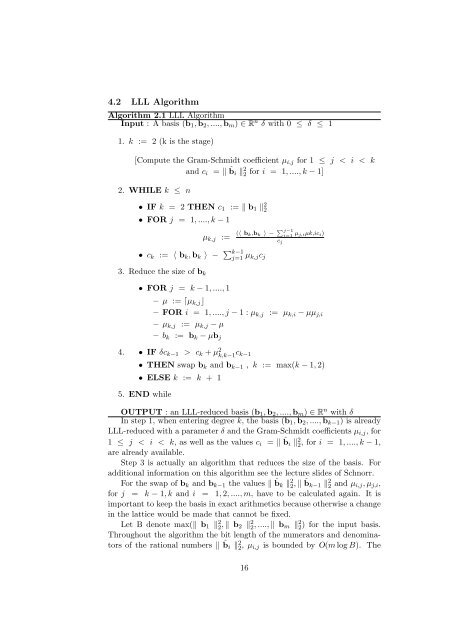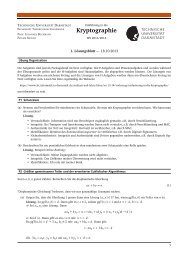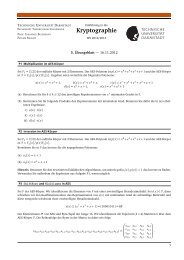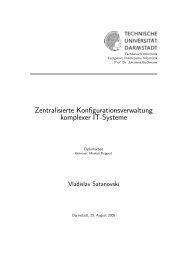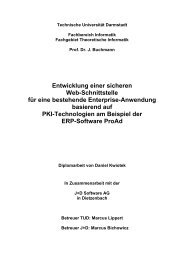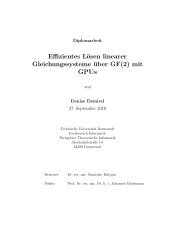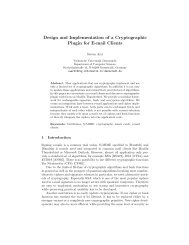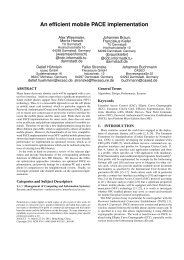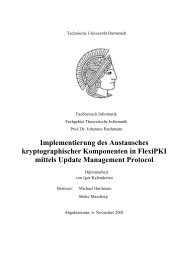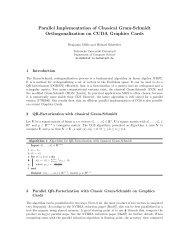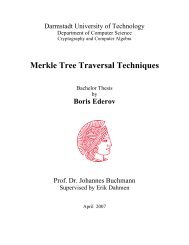Lattice Basis Reduction in Infinity Norm - Technische Universität ...
Lattice Basis Reduction in Infinity Norm - Technische Universität ...
Lattice Basis Reduction in Infinity Norm - Technische Universität ...
Create successful ePaper yourself
Turn your PDF publications into a flip-book with our unique Google optimized e-Paper software.
4.2 LLL Algorithm<br />
Algorithm 2.1 LLL Algorithm<br />
Input : A basis (b1, b2, ...., bm) ∈ R n δ with 0 ≤ δ ≤ 1<br />
1. k := 2 (k is the stage)<br />
[Compute the Gram-Schmidt coefficient µi,j for 1 ≤ j < i < k<br />
and ci = � ˆ bi �2 2 for i = 1, ...., k − 1]<br />
2. WHILE k ≤ n<br />
• IF k = 2 THEN c1 := � b1 � 2 2<br />
• FOR j = 1, ...., k − 1<br />
µk,j := (〈 bk,bk 〉 − � j−1<br />
i=1 µj,iµk,ici)<br />
cj<br />
• ck := 〈 bk, bk 〉 − � k−1<br />
j=1 µk,jcj<br />
3. Reduce the size of bk<br />
• FOR j = k − 1, ...., 1<br />
– µ := ⌈µk,j⌋<br />
– FOR i = 1, ...., j − 1 : µk,j := µk,i − µµj,i<br />
– µk,j := µk,j − µ<br />
– bk := bk − µbj<br />
4. • IF δck−1 > ck + µ 2 k,k−1 ck−1<br />
• THEN swap bk and bk−1 , k := max(k − 1, 2)<br />
• ELSE k := k + 1<br />
5. END while<br />
OUTPUT : an LLL-reduced basis (b1, b2, ...., bm) ∈ Rn with δ<br />
In step 1, when enter<strong>in</strong>g degree k, the basis (b1, b2, ...., bk−1) is already<br />
LLL-reduced with a parameter δ and the Gram-Schmidt coefficients µi,j, for<br />
1 ≤ j < i < k, as well as the values ci = � ˆ bi �2 2 , for i = 1, ...., k − 1,<br />
are already available.<br />
Step 3 is actually an algorithm that reduces the size of the basis. For<br />
additional <strong>in</strong>formation on this algorithm see the lecture slides of Schnorr.<br />
For the swap of bk and bk−1 the values � ˆ bk �2 2 , � ˆ bk−1 �2 2 and µi,j, µj,i,<br />
for j = k − 1, k and i = 1, 2, ...., m, have to be calculated aga<strong>in</strong>. It is<br />
important to keep the basis <strong>in</strong> exact arithmetics because otherwise a change<br />
<strong>in</strong> the lattice would be made that cannot be fixed.<br />
Let B denote max(� b1 �2 2 , � b2 �2 2 , ...., � bm �2 2 ) for the <strong>in</strong>put basis.<br />
Throughout the algorithm the bit length of the numerators and denom<strong>in</strong>ators<br />
of the rational numbers � ˆ bi �2 2 , µi,j is bounded by O(m log B). The<br />
16


